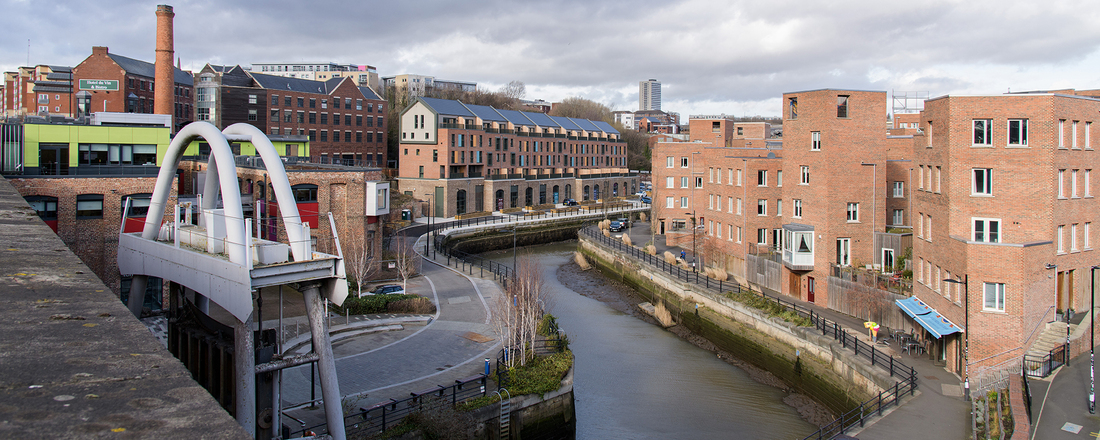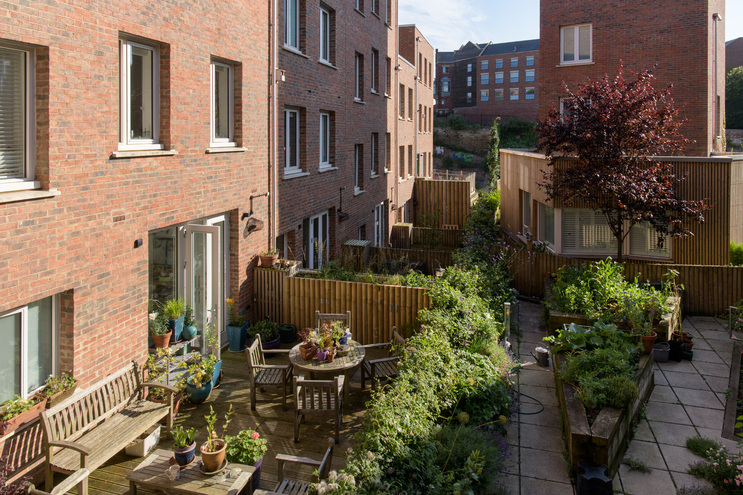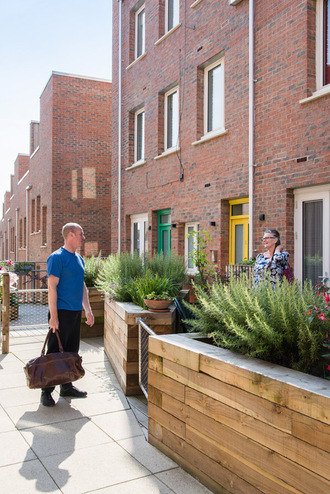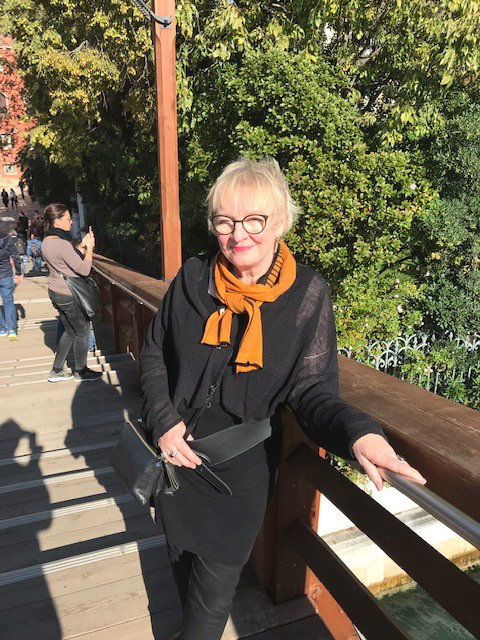Get updates from The Developer straight to your inbox Yes, please!
The Malings, Ouseburn: “I finally felt like I belonged somewhere”
Once a post-industrial wasteland, Ouseburn in Newcastle is now one of the “coolest neighbourhoods on the planet”. Will the next tranche of development live up to the high standards of the last? Loujane Alasi reports

Newcastle is a city renowned for its industrial heritage, bustling nightlight, Geordie dialect, Greggs and of course, the Toon army. Now we can add Newcastle’s Ouseburn to that list, with Time Out magazine having named it as one of the ‘coolest neighbourhoods on the planet’, ranking it 29th out of 49, alongside neighbourhoods in London, New York and Seoul.
Cradled between Newcastle City Centre, Quayside & Byker, the Ouseburn Valley can only be described as a hidden gem. The Ouseburn Trust once called it a “post-industrial wasteland”.
It’s difficult to pinpoint the exact turning point for the Valley, but housing development The Malings, a joint venture between Newcastle City Council, Homes England and PfP Igloo (a partnership between PfP Capital with Igloo Regeneration) is a definite marker on the way.
Chris Barnard, Chief Officer at Ouseburn Trust says, “Prior to The Malings, there was very little housing in the Valley itself. Traditional industries like car garages and industrial units have reduced in number since the growth in housing began.”
Designed by Ash Sakula Architects and completed in 2017, The Malings is a low-rise, high-density housing project of 76 “eco-friendly” homes and three commercial units designed to nurture a “genuine sense of cohesion and engagement among the inhabitants”.
“When Igloo took over the site as a developer, they procured all the designs. They drove the whole project and gained a lot of awards. Almost immediately a sense of community was formed”
The Malings was named the Supreme Winner of the Housing Design Awards in 2016 and scooped the RIBA North East Award in 2017. In 2019, the development was acclaimed by the "Building Better, Building Beautiful" Commission as an example of beauty in British housing design.
“When Igloo took over the site as a developer, they procured all the designs. They drove the whole project and gained a lot of awards. Almost immediately a sense of community was formed,” a spokesperson for Newcastle City Council writes. “The Malings was a key milestone that has set the benchmark for what’s to follow.”
The Malings is just the first phase of 300 homes coming to the Ouseburn, with the 28-home Lower Steenberg’s Yard on the opposite bank having completed last year. Phases 3 to 5 include the controversial Malmo Quay and Spiller’s Quay, the Glasshouses and Maling Street.
“Our vision has always been for the Ouseburn character to be embraced and amplified by the people setting up home here,” David Roberts, Director of Igloo Regeneration, explains. “This shaped why and how we engaged with Ouseburn Trust, from our first contact in 2006 and throughout the last 16 years.”
But what’s it like to actually live there? For semi-retired Professor of Sociology and Director of Malings Freehold Management Company Ltd, Sue Scott, choosing to live in Malings wasn’t a straightforward decision. “I can’t remember how I first noticed The Mailings. I read something somewhere and started to watch what was happening… I came and had a look and a wander around with my partner and some friends. It didn’t look so interesting. It all looked a bit squashed in together. And I thought maybe not.”
On this particular February afternoon, as we speak over Zoom, Scott’s room in The Malings is flooded with light. For Scott, that was the “most important” element: “It’s full of light. It faces all the right directions. It just really mattered that there was sunshine.
“All the rooms are slightly funny shapes, and there are lots of windows and I just really liked it. Whilst it’s not as ecological as I’d hoped it might be, there are some nods in that direction, if you like, that was quite important.”
Designed with community and placemaking in mind, Ash Sakula incorporated low walls and planters to encourage conversations between neighbours and ensured separation distances were kept to a minimum. Roberts calls these “fuzzy borders – both physically and psychologically, between the new development and the Valley as a whole.
Ash Sakula incorporated low walls and planters to encourage conversations between neighbours and ensured separation distances were kept to a minimum. Roberts calls these “fuzzy borders – both physically and psychologically
“Moves like the micro-allotments – small shared growing spaces between the blocks, where residents immediately self-organised and have been growing stuff ever since – fed into close relationships between residents and the Trust, quickly leading to gardening clubs and footpath clean-up groups,” Roberts adds. There’s also a Community Fund, which all Malings residents and businesses pay into and manage the provision of grants.
Nick Simpson, an architect touring the area comments on the placemaking: “The Malings is a great piece of housing design. It feels safe, interesting and friendly, by ignoring several of the rules most housing is designed to.”
A tight-knit community has indeed been formed with a dedicated WhatsApp group. “If you need a plumber, you just need to put a message on the WhatsApp group and somebody will tell you a good plumber or a good electrician. People do all sorts of jobs and bits and pieces for each other,” explained RAF Veteran and Performance Coach, Martin Wintermeyer, who has lived in The Malings for several years.
Wintermeyer spends much of his time volunteering in the local community and he’s even taken it upon himself to become a tour guide for the Ouseburn Trust. When he’s not with the Trust, Wintermeyer is often spotted doing some gardening, river clearing, cycling and volunteering with another local charity Recyke y’bik.
The Trust’s volunteer numbers have swelled in recent years. “New residents are keen to support the work we do and the future of the Valley,” explains Barnard. If ever there was a measure of a community willing to make a difference, volunteering is one.
With Covid-19 having impacted social gatherings in recent years and several properties being leased, community tightness isn’t quite what it used to be. Still, Scott says, “There is a sense that this is a bit of a special place. Ultimately this development is a context for people who want to be neighbourly and who want to come together.”
On the ground floor of The Malings, three commercial units face directly towards the River Ouseburn and Steenberg’s Yard. Northern Rye, a handcrafted, small-batch bakery specialising in sourdough bread, is one of the independent businesses located there. Founder of Northern Rye, Robbie Livingstone, stumbled upon what he described as the “perfect space” located a stone’s throw away from their bakery in Byker. Next door to the bakery is another much loved independent, family-run business, Di Meo’s Riverside Ouseburn, offering national award-winning gelato.
For Northern Rye employee and single-parent, Vivien Wiener, the first time she visited Ouseburn was around eight years ago when she first moved to the region. “We were looking at all these little boats, but apart from that, I can’t remember anything other than saying we should come here more often. And then I’ve never been back for a number of years until I got the job. I never thought much of the area until now.”
“There is a sense that this is a bit of a special place. Ultimately this development is a context for people who want to be neighbourly and who want to come together”
Having joined the bakery in 2021, amidst the madness of the pandemic, Wiener found something special in her new role, “I finally felt like I belonged somewhere. That’s what I love about the place.”
“We know a lot of the residents personally, we know about little bits of their lives and it’s just nice to see their faces. They love the shop, we love them and I think they love each other because I have seen instances where they trust each other. It’s a good community.”
There are fears, however, that Ouseburn’s newfound popularity and international recognition is already changing the character of the place and causing property prices to increase.
Nowadays, the average Malings home is valued at anywhere between a quarter and half a million pounds. As the area witnesses further development there are fears that the quirky creative studios, artisanal bakeries and music venues that have hosted the likes of the Arctic Monkeys could be forced out. “I don’t want that, because then it’s not the Ouseburn anymore for me,” says Wiener. “It becomes something completely different.”
The Ouseburn Trust is worried, but is making an effort to “ensure provision for artists and makers remains despite cost increases,” explains Barnard.
“Residential is more economically viable so almost all developers seek permission for residential schemes,” says Barnard. “It is not housing that gives the Ouseburn its special character, so too much [housing] will erode what makes it special. It is the Trust’s view that we must maintain each of the uses in the Valley in balance – live, work and play must be attributed equal value in the future design.”
“We would like to see some more and varied workspaces for business, and places for a variety of people to visit and spend leisure time like the Farm and Seven Stories and the Victoria Tunnel,” Barnard states.
The Ouseburn Trust said there was an “overwhelming dislike” for the future phases of the projects in Ouseburn, citing fears they don’t live up to the standard set by The Malings
Roberts believes a more joined-up approach with public landowners Homes England and the City Council, including accepting lower land receipts and reduced housing numbers, would enable breathing space for the local creative economy to remain viable. “The place needs the music practice space, artists’ rooms and maker workshops to stay,” he says.
“On a positive note,” Roberts adds, “we have seen the spending power of new residents enabling the opening up of new business in the immediate area… both next to the Malings and within the scheme itself. And fears of pressure on live music venues such as the Tyne Bar to curtail their events have been completely negated by a combination of careful sound insulation and sensitive neighbourliness – and the fact that these venues are part of the draw for residents in the first place.”
There are also concerns about changes to the riverside’s character. Last week, PfP Igloo asked Newcastle City Council to put its planning application on hold while it reworked the design for a future 18-storey tower on Malmo Quay, which received more than 2,000 objections. Malmo Quay, designed by White Arkitekter, lies at the mouth of the River Ouse and, if built, would be one of the tallest buildings in Newcastle.
The Ouseburn Trust said there was an “overwhelming dislike” for the future phases of the projects in Ouseburn, citing fears they don’t live up to the standard set by The Malings and Steenberg’s Yard. It is the Trust’s view that any future design must maintain each of the uses in the Valley in balance – live, work and play.
“Our best chance of preserving what we value and securing a future we can be happy with is to retain our influence and be prepared to work with those seeking to bring about that change to ensure we see a change that is right for Ouseburn,” stresses Barnard.
Pub manager Mick Potts at the Free Trade Inn told the Local Democracy Reporter that the tower’s height was inappropriate for the area and would ruin views for local people and businesses. Consequently, the design was labelled a “monstrosity” by local residents.
Ouseburn councillor Gareth Kane, who “really liked” the wider development, says “the tower sticks out like a sore thumb.” He told The Chronicle he would prefer a “more human-size development or public realm”.
“It is a shame that social media is reducing discourse to a binary ‘stop this monstrosity’ rallying cry”
“It is clear that people have come out to express concerns over proposals for Phase 3 on Malmo Quay. Hopefully, the fact that we are pausing to consider the proposals again with landowners Homes England demonstrates the care that the team is taking to get this right,” Roberts responds.
“The challenge is in delivering the housing numbers that are being proposed on a site with hugely expensive and intrusive below-ground infrastructure – main sewers and river-wall tie rods being the principal complications,” says Roberts. “Continued dialogue is to be encouraged, but it is a shame that social media is reducing discourse to a binary ‘stop this monstrosity’ rallying cry.”
However Roberts shares concerns about the quality of future development coming to the Ouseburn Valley, “I remain bitterly opposed to the wholly incongruous Whey Aye Wheel and the surrounding Giants of the Quayside leisure boxes due to be developed on Spillers Quay, adjacent our Phase 4 scheme. I believe there remains the potential for this former Homes England site to deliver a mixed use scheme of private and affordable homes with workplaces far better related to the Valley and the Byker ward next door.
“I know the Council supported this scheme but personally I think that was a big mistake, and sincerely hope it doesn’t go ahead,” says Roberts.
Loujane Alasi is a journalist and media and communications officer based in Newcastle upon Tyne
Sign up to our newsletter
Get updates from The Developer straight to your inbox
Thanks to our organisation members
© Festival of Place - Tweak Ltd., 124 City Road, London, EC1V 2NX. Tel: 020 3326 7238
© Festival of Place - Tweak Ltd., 124 City Road, London, EC1V 2NX. Tel: 020 3326 7238





